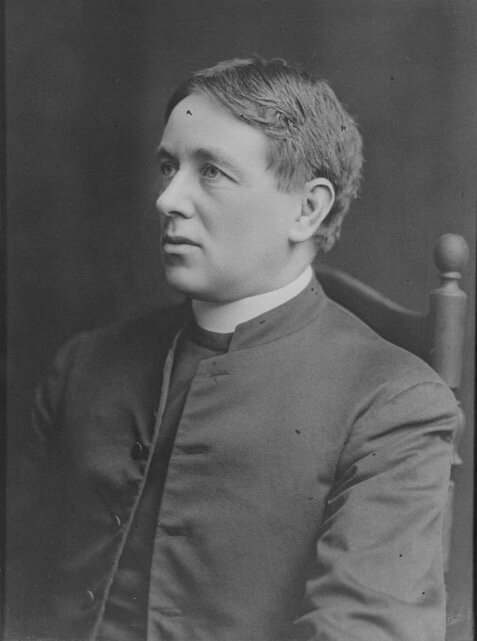Old St. Stephen’s had a farm!
The original Rector’s Office in the 1888 Parish House currently displays, on a windowsill facing the office’s main door, three photographs from the turn of the twentieth century, identified as showing aspects of St. Stephen’s “farm.”
Their focus is the Farm’s social use outdoors: a porch and lawn gathering; a religious service; Sunday School. Their vintage labeled mats and frames further confirm they were shown in this form well before our time. Today we know little about the Farm other than it lost the importance it once had.
Once again the archives and Mike Krasulski’s “philadelphiastudies.org” restore much to light. St. Stephen’s indeed owned and operated a farm close to Philadelphia for twenty-two years, beginning in 1898. One oddity especially intrigued me: Hailed as the parish’s “most successful enterprise” when it first opened, the Farm was quietly sold in 1920 with no visible explanation. So for how long and where were the framed photographs displayed?
Even this preliminary search gives us intriguing new dimensions of the very urban St. Stephen’s and the Diocese in challenging times.
Credit for the venture goes to St. Stephen’s then-rector, The Rev. Elwood Worcester PHD, who moved fast.
Two years into his rectorship, on February 9. 1898, he told the Vestry that, in addition to St. Stephen’s local services for the needy, he’d been thinking it might buy a farm near the city “where the poor children and others connected with the Parish who could not afford to leave the city during the summer months might be sent.” By late March he and a vestryman had found a farm of about 100 acres, 18 miles from the city near Hatboro and conveniently near the North East Pennsylvania Railroad. The church quickly bought and refurbished the property. By that summer, the farm was at work as St. Stephen’s country mission for the urban poor. The October parish newsletter reported 500 persons enjoyed the season; 120 of them “regular boarders.”
Accounts of St. Stephen’s Farm and its activities from this first year reveal an ambitious and wide-ranging program. First, claimed The Parish News, it provided a means to give pleasure and to restore the health of urban girls and women in this “wholesome country life.” It then quoted a positive review of the enterprise in a Swiss newspaper that further claimed the girls would learn domestic skills and the boys would work on the farm [run by a tenant farmer who sold produce and livestock for the church]—dignity and health in labor, and marketable experience, according to current thought. The Swiss newspaper applauded this practical side of Christianity as one of the most laudable features of American churches today. The parish’s official report to the Diocesan Convention at year’s end added yet another feature of the farm in winter: as a “sanitarium for women and girls.”
This all seems so commonplace today. Such missions, however, apparently emerged during these very decades, thanks to a sea change in attitudes.
The late nineteenth century, we’ve long known, saw many strong reactions against the ills of industrialism and the modern city. One perceived antidote: nature. Such a view dramatically elevated the moral status of the countryside and wilderness, which had evolved, in the eighteenth century, from the feared chaotic realm of evil into God’s beneficent creation, a site of grace. For Enlightenment thinkers, nature was the positive force that drove all truth and progress; the outdoors was the ultimate moral zone available to humanity—even urban streets and parks. Simultaneously, many, following Jean-Jacques Rousseau and certain Protestant groups (including St. Stephen’s), came to see childhood as a state of original innocence that responsible education could develop.
According to these views, young people, especially the underprivileged of the city, needed even brief exposure to nature to grow spiritually and physically. Beginning in the 1860s, American summer camps in nature burgeoned; faith-based groups supported the Fresh Air Fund (initiated by a Congregationalist minister in New York City in 1877) to send urban youth to Pennsylvania farm families. Sanitariums for victims of tuberculosis had existed since the 1830s, most often in highlands but always in healing nature. Such resources, however, were rarely available to the urban poor, among whom the disease was common. St. Stephen’s developed its own healing and learning center in what it called “God’s out of doors” for parish and city needy, not for privileged parishioners.
The Diocese contributed decisively to a less familiar innovation in the program. St. Stephen’s new farm mission was run by Sister Elizabeth Davis, who otherwise managed the parish’s city programs for girls and women. She was one of the Diocese’s new deaconesses from the Deaconess House established in Philadelphia in 1891 to place women in professional positions within local parishes, often in missions of mercy. This course for social action differs from the more monastic Episcopal sisterhoods established shortly before. The Diocese’s enterprise was part of a broader Deaconess Movement begun in the 1840s in Protestant Europe inspired by deaconesses of the Early Church.
By the opening of the twentieth century St. Stephen’s presented the Farm as one of its three programmatic cornerstones, to judge by issues of The Parish News of those years. The front covers bear a photograph of the church and Parish House; the back covers, the Burd Asylum (St. Stephen’s orphanage and originally school for legitimate white girls); and inside the back covers, St. Stephen’s Farm.
For its activities and shifting fortunes, stay tuned for Part II!
—Suzanne Glover Lindsay, St. Stephen’s historian


